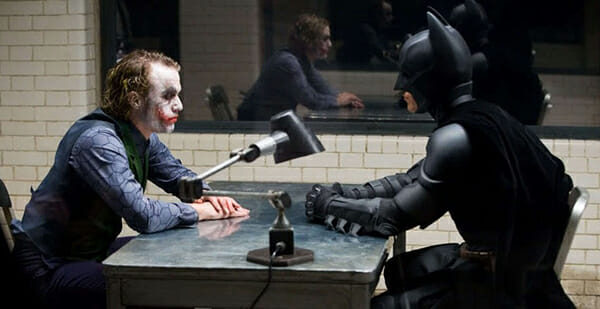By Shaun Leonard · August 8, 2017

Characters who face nameless henchman for an entire movie don’t tend to be that interesting. What’s more, if the threats our heroes face aren’t specific or engaging in themselves, why would we care about characters overcoming them? This isn’t just a general note about making the bad guys edgy and dangerous, though that is certainly one way to go. This is a fact: Conflict in a film works best when it’s between characters we care about, rather than a one-sided struggle between interesting good guys and boring bad guys. And this fact applies to comedies and love stories just as much as blockbusters.
Take the recent Will Ferrell and Amy Poehler comedy The House. The focus of the film is on our characters running an illegal casino in the suburbs. It’s a good premise that makes us imagine the kind of trouble our heroes could get into. Unfortunately, their actual obstacles are vague and lack credibility. There’s crooked politicians and dangerous mobsters, which should be exciting, but end up being minor stumbling blocks without consequences. The characters we actually spend time with never disagree about anything, so we don’t have that to invest in either. Things just happen, and then more things happen. This is not the stuff of great comedy.
 A lot of the same people were involved in the most successful comedies of the past 20 years: Talladega Nights, Anchorman, Step Brothers, Blades of Glory, etc. What’s the difference between those beloved romps and The House? The main characters care about each other, and their differences lead to conflict and strife. In Anchorman, the main character falls for and vehemently dislikes the same person over the course of the film, and Ron Burgundy is perhaps the most famous comedic character of Will Ferrell’s career. It might seem simplistic, but internal conflict within a group is quickly, naturally engaging. While outside forces and villains can make for great comedic stumbling blocks, it takes extra pages to introduce each and every foe.
A lot of the same people were involved in the most successful comedies of the past 20 years: Talladega Nights, Anchorman, Step Brothers, Blades of Glory, etc. What’s the difference between those beloved romps and The House? The main characters care about each other, and their differences lead to conflict and strife. In Anchorman, the main character falls for and vehemently dislikes the same person over the course of the film, and Ron Burgundy is perhaps the most famous comedic character of Will Ferrell’s career. It might seem simplistic, but internal conflict within a group is quickly, naturally engaging. While outside forces and villains can make for great comedic stumbling blocks, it takes extra pages to introduce each and every foe.
Think about any love triangle. For it to be truly tense, we need to care about each of the parties involved. If it’s easy for Bridget Jones to make the choice between Handsome British Man One and Two, then we don’t have a story (or a trilogy). The same goes for Chasing Amy, Pretty in Pink, and yes, even Twilight. Without the tension of Team Jacob versus Team Edward, you don’t get a film franchise that has made over $3 billion to date. And romantic movies that don’t feature a love triangle are the best example of the idea I’m trying to express. Two people are in love, and then they are in conflict. If you can make us care about them, then we will want them to get back together. Will they? Won’t they? Regardless, you have our attention and a ready made three act structure. So, to write a better love story than Twilight, put the characters we care about in conflict with each other.
The best thriller, action, and horror films tend to share one thing: villains that draw our attention. We might be intrigued by Chigurh’s warped point of view in No Country for Old Men, engrossed by Agent Smith’s inhumanity in The Matrix, or simply terrified of Freddy and/or Jason. The secret to this kind of drama is the same in movies as it is in pro wrestling: the better the heel, the more heroic the babyface looks. It’s the difference between The Dark Knight and Thor: The Dark World. The difference between Hans Gruber and whoever the bad guy was in Die Hard 2: Die More Hardly. Simply put, we can’t root for Rocky unless we know he’s up against a worthy opponent. Better yet, we want our heroes to be underdogs, facing rivals that make them look puny by comparison. Imagine how the tension skyrockets when the conflict comes from former friends, turned enemies by circumstance or a difference of belief.

Don’t get me wrong, there are plenty of stories where the conflict comes from the outside. Whether it’s an opposing army or the forces of nature, stories of characters working alone or working in harmony together to overcome a difficulty can be as dramatic as anything. But if you’re going to have characters in conflict, the most direct way of achieving the greatest emotional impact is often having the struggle come from within rather than without. It can save page real estate and enhance the excitement in a personal way, instead of trying to overwhelm the audience with a grand scale. Science-fiction has been having the best of both worlds for years. Global (or intergalactic) conflict is often dependent on the actions of a ragtag group of heroes, or an abstraction is brought to life and made personal. In the end, we go to the movies to see people. Spice things up a bit and have those people crash into each other.
For more from The Script Lab, follow us on Twitter, Facebook, and Instagram.